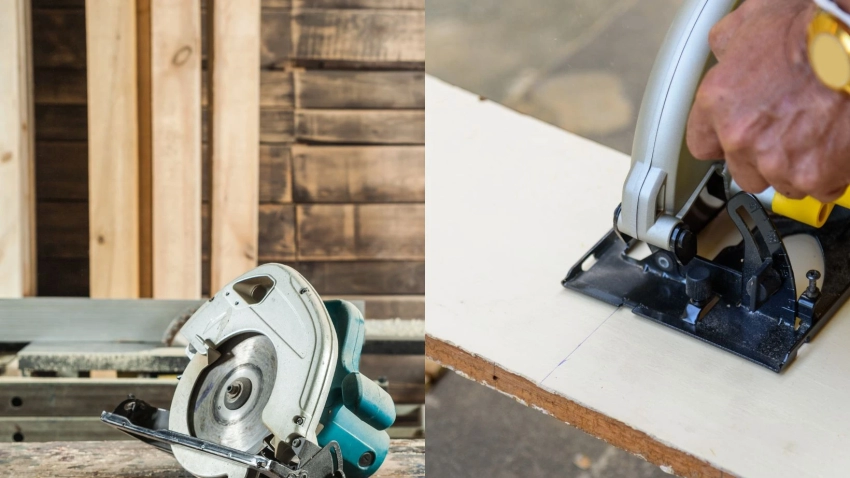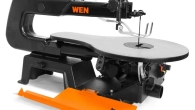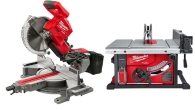
Jigsaw vs Circular Saw: Choosing the Right Tool for the Job
When it comes to DIY projects and woodworking, both jigsaws and circular saws are essential tools. But with some key differences in their functionalities, choosing the right one can make a world of difference in the outcome of your project. This article dives into the specifics of jigsaws and circular saws, helping you navigate their strengths, weaknesses, and ideal applications.
Straight Cuts: Circular Saw Reigns Supreme
For clean and precise straight cuts, particularly in thicker materials like plywood or lumber, the circular saw takes the crown. Its rotating blade, designed for ripping (cutting along the grain) and crosscutting (cutting across the grain), effortlessly slices through wood in a straight line. Most circular saws come with a base plate that doubles as a guide, ensuring a steady hand and a flawless cut.
Jigsaws, on the other hand, struggle with achieving perfectly straight cuts. Their reciprocating blade, which moves up and down rapidly, can cause the saw to wander slightly, resulting in a less than ideal line. While jigsaws can be used for straight cuts with the help of a clamped straightedge, the process is slower and requires more focus to maintain accuracy.

Curved Cuts: Jigsaw Takes the Lead
If your project involves intricate shapes or curved cuts, the jigsaw shines. Its narrow, maneuverable blade allows for sharp turns and tight corners, making it perfect for cutting out countertops, crafting decorative elements, or following curved lines on patterns. With a variety of jigsaw blades available for different materials and cutting applications, you can achieve precise results on wood, laminate, metal, and even plastic.
Circular saws, with their fixed, circular blades, are simply not designed for curved cuts. While bevel cuts (cuts made at an angle) are possible with some circular saws, they are limited in scope and precision. Forcing a circular saw to make a curved cut can not only damage the blade but also lead to uneven or unsafe results.
Power and Speed: Circular Saw Cuts Through
Circular saws are powerhouses when it comes to cutting through thick materials. Their high-powered motors and larger blades make quick work of lumber and other dense materials. This efficiency is crucial for projects that involve ripping long boards or cutting through multiple layers of plywood.
Jigsaws, while versatile, are not as powerful as circular saws. Their smaller blades and lower motor wattage make them less suitable for heavy-duty cutting tasks. While they can handle moderate thicknesses of wood, attempting to force a jigsaw through a thick plank will likely result in a burnt blade, slow progress, and frustration.

Precision and Control: Jigsaw Offers Finesse
Jigsaws excel in terms of control and precision cutting. The small, easily manipulated blade allows for detailed work and intricate cuts. Combined with the ability to adjust the cutting speed, jigsaws provide superior control for delicate projects.
Circular saws, while offering a straighter cut, require a steadier hand due to the larger blade and more powerful motor. While they can be used for precise cuts with a clamped guide, the process is less forgiving than with a jigsaw.
Portability and Ease of Use: Jigsaw Wins on Maneuverability
Jigsaws are generally lighter and more compact than circular saws. This makes them easier to handle and maneuver, especially in tight spaces or for overhead work. Their smaller size also allows for easier storage in toolboxes or on workbenches.
Circular saws, with their larger base plates and motors, can be bulkier and heavier. While some models are designed for portability, they generally require more space and planning for storage and transportation.

Choosing the Right Tool for Your Project
So, which saw should you choose? Here’s a quick breakdown to help you decide:
- For straight cuts in thick materials: Circular Saw
- For intricate shapes and curved cuts: Jigsaw
- For fast and powerful cuts: Circular Saw
- For detailed and precise work: Jigsaw
- For portability and tight spaces: Jigsaw
Beyond the Basics: Additional Considerations
While these core functionalities are key differentiators, there are other factors to consider:
Dust collection:
Both saws can generate significant dust. Look for models with dust collection ports to maintain a cleaner workspace.
Blades:
Jigsaws offer a wider variety of blades for different materials and cutting applications. Choose a circular saw blade with the appropriate number of teeth for the desired cut finish.
Safety features:
Look for features like blade guards, soft start mechanisms, and riving knives (circular saws) to ensure safe operation.

Considering the cost-effectiveness and ease of transport
Circular saws are a popular choice among professionals and construction workers, but their appeal extends beyond just heavy-duty applications. Here’s why they remain a cost-effective and easily transportable option for various users:
-
Cost-Effectiveness: Compared to other power saws, circular saws generally fall within a more affordable price range. This makes them a budget-friendly option for both professional contractors and DIY enthusiasts. While high-end models with advanced features come at a premium, a good quality circular saw can be obtained without breaking the bank.
-
Versatility Meets Value: For the price, a circular saw offers incredible versatility. It tackles a wide range of cutting tasks, from ripping lumber for framing to making quick, clean crosscuts for various projects. This eliminates the need to invest in multiple specialized saws, saving money in the long run.
-
Portable Power: While circular saws aren’t the most compact tools, they are designed for portability. Many models are lightweight and come with comfortable handles, making them easy to carry around a job site or store in a toolbox. Additionally, the growing popularity of cordless circular saws offers even greater portability and convenience, eliminating the need for extension cords.
-
Ease of Use: Circular saws are known for their user-friendly design. Learning to operate a circular saw with basic safety precautions doesn’t require extensive training. This makes them suitable for both seasoned professionals and DIYers who are new to working with power tools.
In conclusion, circular saws strike a remarkable balance between affordability, ease of transport, and powerful performance. This combination makes them a valuable asset for professional contractors, construction workers, and DIY enthusiasts alike.
Circular saw’s popularity among professionals and construction workers
Circular saws are undeniably popular tools among professionals and construction workers for several reasons:
- Versatility: They can handle a wide range of cutting tasks, from ripping lumber to making bevel cuts for crown molding.
- Power and Efficiency: Their high-powered motors and larger blades allow for quick and effortless cutting through thick materials, saving time and effort on the job site.
- Durability: Circular saws are built to withstand the rigors of everyday use on construction sites. They’re often constructed with tougher materials and feature robust motors designed for long-lasting performance.
- Portability: While not the most compact tool, many circular saws are lightweight and portable enough to be easily transported around a job site. Cordless models offer even greater flexibility.
- Straight Cuts: Professionals rely heavily on precise straight cuts for framing, sheathing, and various other construction tasks. Circular saws excel in this area, delivering clean and accurate cuts with the help of their base plate guides.
While other saws have their niche applications, the circular saw’s ability to handle various cutting tasks efficiently and precisely makes it a go-to tool for many professionals and construction workers.

Conclusion: A Perfect Pairing for Your Workshop
Ultimately, jigsaws and circular saws are not mutually exclusive. In fact, having both in your toolbox provides a well-rounded solution for most woodworking projects. The circular saw tackles the heavy lifting and straight cuts, while the jigsaw swoops in for intricate details.












Leave a Reply